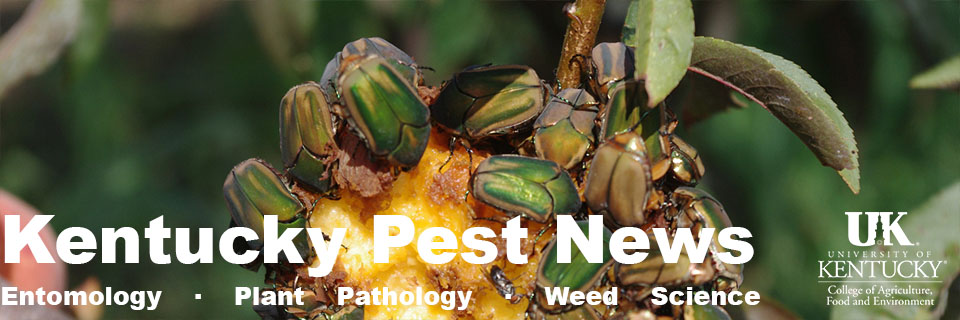Wheat fields will soon be at the anthesis stage (Feekes 10.51, “flowering”) in Kentucky. Anthesis is a critical time, as wheat becomes susceptible to infection by Fusarium graminearum, the causal agent of Fusarium head blight (FHB; also known as scab) (Figure…
Monthly Archives: April 2021
Fire Blight Alert and Risk Map Overview
Apple bloom is nearing completion across Kentucky, while bloom in pear trees has been complete for a couple weeks. Infection by the fire blight bacterium occurs during bloom, thus, protectant antibiotics should be applied when risk is high. Risk for…
Dogwood Anthracnose Spotted
Anthracnose of dogwood is a common problem in Kentucky. Symptoms on landscape and forest dogwoods often first appear during wet periods in late spring. If left unmanaged, the pathogen spreads, eventually resulting in plant death. Selection of resistant varieties and…
Alfalfa Weevil and Insecticide Resistance
This past week, I received a report of high levels of alfalfa weevil larvae following an insecticide application. The producer was concerned that the insecticide he was using was not effective. I visited with the grower and collected several hundred…
An IPM Scouting Guide for Common Problems of Strawberry in Kentucky (ID-238)
Scouting and monitoring crops to determine potential problems before they result in serious economic loss is key to the Integrated Pest Management (IPM) approach. This IPM guide was designed to aid in the identification of common problems encountered in strawberry…
2021 Insect Trap Counts
Trap counts for major insect pests are provided by the Kentucky IPM Program. Traps are located at the UK Research and Education Center in western Kentucky and the UK Spindletop Farm in Lexington. Below are trap counts for the current…
Fire Blight Alert and Risk Map Overview
Apple and pear trees are blooming across Kentucky. Infection by the fire blight bacterium occurs during bloom, thus, protectant antibiotics should be applied when risk is high. Risk for infection can be assessed using the Fire Blight Disease Prediction Model.…
Early-Season Strawberry Insect Management
There are several insect and insect-related early-season pests of strawberry that need to be monitored and, at times, controlled to prevent losses. This includes spider mites, tarnished plant bug, spittlebug, spotted wing drosophila (SWD), sap beetles, and slugs. While SWD…
Bacterial Wetwood and Slime Flux
Bacterial wetwood and slime flux refer to bacterial “ooze” that runs down trunks of trees. Oozing fluids are the result of a bacterial infection known as bacterial wetwood (Figure 1). Advanced development is called slime flux, in which a foul-smelling,…
Last Year’s Ornamental Diseases Equal This Year’s Disease Risk
Disease presence last year can indicate a risk for the same disease this year. Many pathogens overwinter on infected plant material or as pathogen survival structures. Poor sanitation practices can lead to an increased risk of these diseases in the…
Commercial Strawberry Fungicide Spray Schedule Worksheet & Sample Spray Guide (PPFS-FR-S-26)
A worksheet with a sample spray guide is available for commercial strawberry growers. This easy-to-use two-page publication is designed to assist growers in planning an appropriate fungicide spray schedule for common strawberry diseases. Commercial Strawberry Fungicide Spray Schedule Worksheet &…
2021 Insect Trap Counts
Trap counts for major insect pests are provided by the Kentucky IPM Program. Traps are located at the UK Research and Education Center in western Kentucky and the UK Spindletop Farm in Lexington. Below are trap counts for the current…
It’s Time to Sample for Soybean Cyst Nematode in Your Fields
The soybean cyst nematode (SCN) (Figure 1) causes greater annual yield losses in Kentucky than any other pathogen of soybean. The last time a formal survey was conducted by the University of Kentucky in 2006 and 2007, approximately 76% of…
Last Year’s Hemp Diseases Equal This Year’s Disease Risk
Disease presence last year can indicate a risk for the same disease this year. Many pathogens overwinter on infected plant material or as pathogen survival structures. Poor sanitation practices can lead to an increased risk of these diseases in the…
Fire Blight Alert and Risk Map Overview
Apple and pear trees are blooming across Kentucky. Infection by the fire blight bacterium occurs during bloom, thus, protectant antibiotics should be applied when risk is high. Risk for infection can be assessed using the Fire Blight Disease Prediction Model.…
